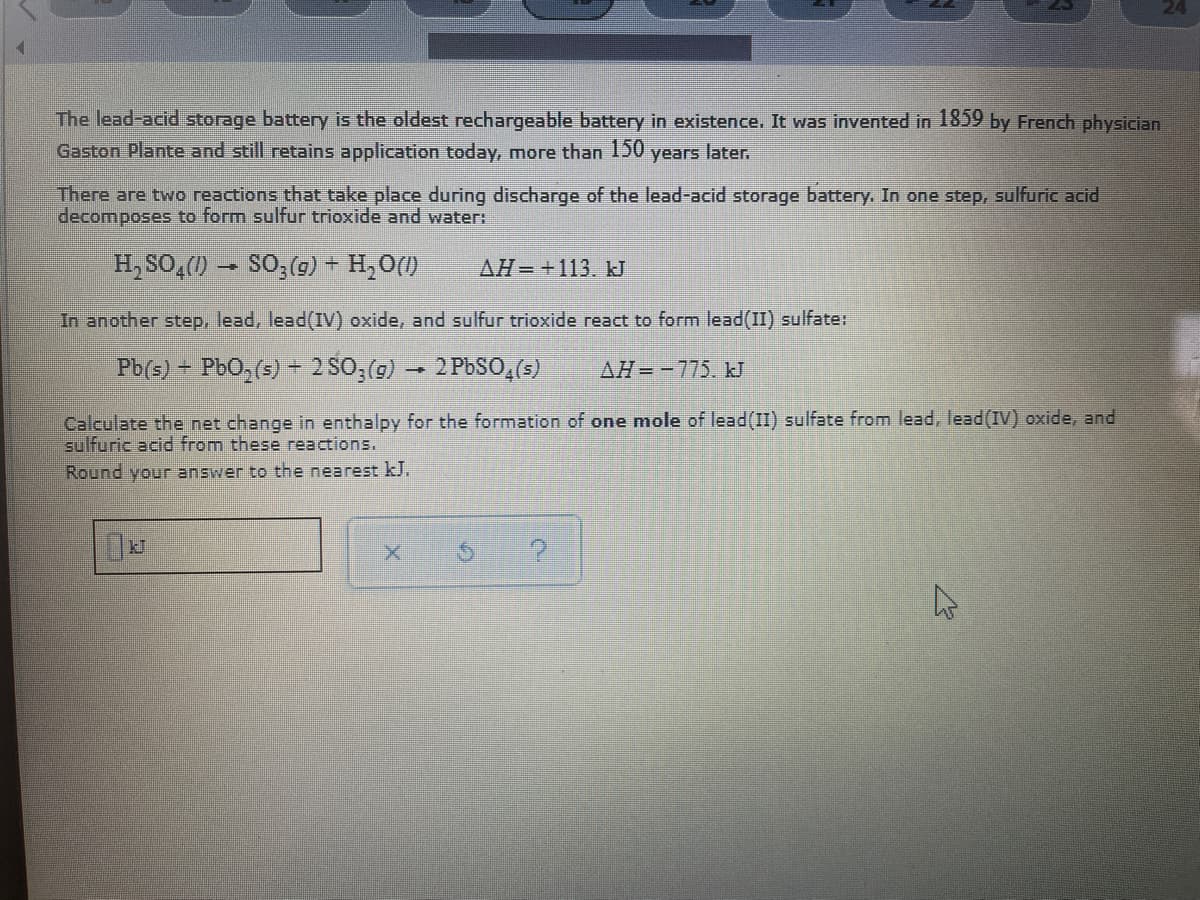The lead-acid storage battery is the oldest rechargeable battery in existence. It was invented in 1859 by French physician Gaston Plante and still retains application today, more than 150 years later. There are two reactions that take place during discharge of the lead-acid storage battery. In one step, sulfuric acid decomposes to form sulfur trioxide and water: H, SO,() – SO;(g) + H, O(1) AH=+113. kJ In another step, lead, lead(IV) oxide, and sulfur trioxide react to form lead(II) sulfate: Pb(s) - PbO, (5) + 2 SO,(g) 2 PBSO,(s) AH=-775. kJ Calculate the net change in enthalpy for the formation of one mole of lead(II) sulfate from lead, lead(IV) oxide, and sulfuric acid from these reactions. Round your answer to the nearest kJ.
The lead-acid storage battery is the oldest rechargeable battery in existence. It was invented in 1859 by French physician Gaston Plante and still retains application today, more than 150 years later. There are two reactions that take place during discharge of the lead-acid storage battery. In one step, sulfuric acid decomposes to form sulfur trioxide and water: H, SO,() – SO;(g) + H, O(1) AH=+113. kJ In another step, lead, lead(IV) oxide, and sulfur trioxide react to form lead(II) sulfate: Pb(s) - PbO, (5) + 2 SO,(g) 2 PBSO,(s) AH=-775. kJ Calculate the net change in enthalpy for the formation of one mole of lead(II) sulfate from lead, lead(IV) oxide, and sulfuric acid from these reactions. Round your answer to the nearest kJ.
Chemistry: An Atoms First Approach
2nd Edition
ISBN:9781305079243
Author:Steven S. Zumdahl, Susan A. Zumdahl
Publisher:Steven S. Zumdahl, Susan A. Zumdahl
Chapter17: Electrochemistry
Section: Chapter Questions
Problem 50E: The amount of manganese in steel is determined by changing it to permanganate ion. The steel is...
Related questions
Question
100%

Transcribed Image Text:The lead-acid storage battery is the oldest rechargeable battery in existence. It was invented in 1859 by French physician
Gaston Plante and still retains application todaY, more than 150
years later.
There are two reactions that take place during discharge of the lead-acid storage battery. In one step, sulfuric acid
decomposes to form sulfur trioxide and water:
H, SO,() – SO;(9) + H,O()
AH-+113. kJ
In another step, lead, lead(IV) oxide, and sulfur trioxide react to form lead(II) sulfate:
Pb(s) – PbO,(s) - 2 S0, (g) → 2 PbSO,(s)
AH= -775. J
Calculate the net change in enthalpy for the formation of one mole of lead(II) sulfate from lead, lead(IV) oxide, and
sulfuric acid from these reactions.
Round your answer to the nearest kJ.
Expert Solution
This question has been solved!
Explore an expertly crafted, step-by-step solution for a thorough understanding of key concepts.
Step by step
Solved in 2 steps

Knowledge Booster
Learn more about
Need a deep-dive on the concept behind this application? Look no further. Learn more about this topic, chemistry and related others by exploring similar questions and additional content below.Recommended textbooks for you

Chemistry: An Atoms First Approach
Chemistry
ISBN:
9781305079243
Author:
Steven S. Zumdahl, Susan A. Zumdahl
Publisher:
Cengage Learning


Chemistry
Chemistry
ISBN:
9781305957404
Author:
Steven S. Zumdahl, Susan A. Zumdahl, Donald J. DeCoste
Publisher:
Cengage Learning

Chemistry: An Atoms First Approach
Chemistry
ISBN:
9781305079243
Author:
Steven S. Zumdahl, Susan A. Zumdahl
Publisher:
Cengage Learning


Chemistry
Chemistry
ISBN:
9781305957404
Author:
Steven S. Zumdahl, Susan A. Zumdahl, Donald J. DeCoste
Publisher:
Cengage Learning

Chemistry: The Molecular Science
Chemistry
ISBN:
9781285199047
Author:
John W. Moore, Conrad L. Stanitski
Publisher:
Cengage Learning

Principles of Modern Chemistry
Chemistry
ISBN:
9781305079113
Author:
David W. Oxtoby, H. Pat Gillis, Laurie J. Butler
Publisher:
Cengage Learning

Chemistry: Principles and Reactions
Chemistry
ISBN:
9781305079373
Author:
William L. Masterton, Cecile N. Hurley
Publisher:
Cengage Learning